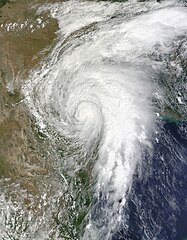Latest from Jeff Lindner:
Very active radar early this morning with numerous thunderstorms developing within a zone of surface moisture convergence from SE of Lake Charles to near Smith Point (Galveston Bay). Weak tropical wave noted south of Sabine Pass, TX moving westward and this is the feature responsible for all the ongoing activity early this morning.
Main question today is how far west and inland the storms penetrate. Another disappointing day yesterday rainfall wise as early morning showers put a lid on building afternoon instability keep activity fairly scattered. Moisture is deeper today with PWS of 2.2-2.4 inches across the region and the radar does look promising, but I have seen day after day over the past week of development in this same area spreading thick mid and high level cloud cover over the rest of SE TX and preventing more widespread rains. Difference today does appear to be a good deal of downstream development over Galveston Bay under the thickening cirrus shield, so maybe we will all get some decent rainfall today.
Saturated profile will support periods of very heavy rainfall under the stronger convective cells with hourly rates of 2-3 inches possible in this very tropical air mass.
Tropical wave/upper disturbance will weaken and move westward on Wednesday with less upper support and a slightly drier air mass spreading into the region from the NE. Will go back to our more typical daily afternoon seabreeze 20-30% coverage for Wed-Thurs. Large upper ridge over the central US expands back southward for the weekend while surface high pressure over the eastern Gulf of Mexico builds westward and this should effectively shut off rain chances and force highs back into the 100’s for Fri-Sun. Ridge weakens again early next week and area comes under another period of easterly flow aloft allowing a return to more favorable rain chances.
Tropics:
After peaking late yesterday afternoon at 65mph, Bret has weakened overnight and is looking quite weak this morning with only modest amounts of weak convection near the center. A combination of dry air and increasing upper level wind shear have done their work on the small circulation center and Bret will continue a downward weakening trend until dissipation over the colder waters of the north Atlantic.
Note: Atlantic Sea Level Pressures have rapidly fallen to some of the lowest levels recorded in the past 50 years comparing closely to the same time in the 2005 hurricane season. The decline in SLP is concerning especially during the upcoming months of August and September and such low pressures help breed more frequent and more intense tropical cyclones. All parameters remain favorable for a significant increase in tropical cyclone activity basin wide starting in the next few weeks.
We'll see what actually happens. Radar is once again looking very promising, but we have saw this yesterday too and many areas got nothing.
.






 my Cowboys
my Cowboys 





